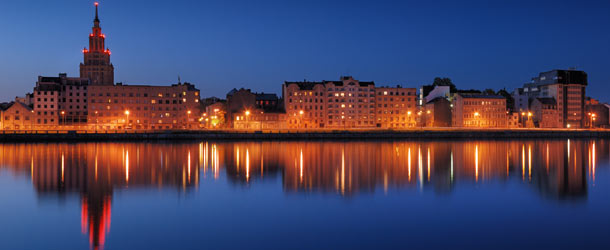I’ve been blogging quite a bit recently about some of the Baltic and Nordic capitals you’re likely to visit while on a northern Europe cruise but it may surprise you to learn that many shorter Baltics cruises don’t in fact include a stop at what is in fact the region’s largest city, the Latvian capital of Riga. There are however plenty of cruises available which do, with the likes of Royal Caribbean and Thomson visiting the city, so with that in mind, I thought I’d take a closer look at this intriguing capital which is growing in popularity as a Baltics cruise destination.
Nestled in the Gulf of Riga, the city is an important a sea port today as it has been throughout its long history and is home to a third of Latvia’s population. Though it was founded in 1201, Riga traces its origins back to the second century when tribes were first known to have settled in the area on which it now stands. In the Middle Ages, it was an important hub for Viking trade and in 1282 joined the Hanseatic League, which gave it the economic stability to weather the storms which would hit it throughout the following centuries, wrought by the likes of the Holy Roman Empire and the Russian Empire. Latvia declared its independence in 1918 following the end of the First World War with Riga as its capital, which was occupied by German forces for much of the Second World War. The city’s long and fascinating history makes it a great place to explore.
Landmarks
If you only had time to check out one landmark in Riga, you’d be advised to head for the Town Hall Square. The city’s leading tourist hotspot, it offers everything you’d expect from an old Baltic city – cobbles streets, old buildings and quant eateries – but it’s also where you’ll find possibly Riga’s most photographed building, the House of Blackheads. Once the hangout of the Brotherhood of Foreign Merchants, it dates back to 1334, though was rebuilt throughout the mid to late 90s following a long period of disuse after being demolished during the Second World War. Today, it functions as both a concert hall and a museum. One of the city’s most visible landmarks is the tower of St Peter’s Church, and you should certainly head here if you want to enjoy on of the best views of Riga from above. The most notable reference to the country’s past political struggles is another popular landmark – the Freedom Monument. The statue holds three stars, signifying the country’s three regions and the impassive and seemingly identical guard of honour who march before it are a popular part of the monument’s appeal. Another important landmark which honours a dark chapter in Riga’s history is the Great Choral Synagogue Memorial, located in the area where the Riga Jewish Ghetto during the Second World War.
Culture
As well as key landmarks, there’s a wealth of cultural sites to experience in Riga and the city was awarded UNESCO World Heritage Site status thanks largely to its beautiful Art Nouveau centre. Jugenda Stila Nami is one of the best areas to visit if this architectural style is of interest to you, with Albert Street being home to some of the finest examples, where virtually every building is an architectural gem. The city also has its fair share of key religious sites to visit too. As well as the aforementioned St Peter’s Church, the Russian Orthodox Nativity of Christ Cathedral is popular place to visit, and boasts a breathtakingly beautiful interior with an abundance of gold. St Mary’s Dome Cathedral is another key religious site, thanks partly to being home to one of the world’s largest pipe organs. There’s an organ performance every half hour too, so you’ll have a good chance of hearing the pipes sing. For opera aficionados, a visit to the Latvian National Opera is a given. A 19th century architectural gem its worth visiting to witness the building even if you’re not a fan, as it’s one of the city’s most celebrated buildings. You can of course enjoy an opera or a ballet if you have a little more time to spend in Riga and tickets are very reasonably priced.
By Simon Brotherton
Google


Comments: no replies